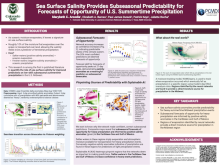Sea Surface Salinity as a Predictor for Subseasonal Forecasts of Opportunity of U.S. Summertime Precipitation within CESM2
Marybeth
Arcodia
Colorado State University
Poster
Global water cycling is a fundamental role of the climate system, directly impacting terrestrial water availability. The majority of moisture that evaporates over the ocean rains out over the ocean, but roughly 10% of that moisture is transported over land, eventually falling as terrestrial precipitation. As oceanic moisture evaporates, it leaves a signature on sea surface salinity, allowing these fields to be a potential predictor of terrestrial precipitation. Previously, salinity has been shown to be a useful predictor for summertime U.S. precipitation one season ahead. However, this study is the first to assess the role of sea surface salinity on subseasonal timescales, particularly on low-skill summertime precipitation predictions. We approach this problem using a neural network setup with CESM2 Large Ensemble model data to quantify predictability of the U.S. Midwest summertime heavy rainfall events for zero to eight week leads provided by Atlantic salinity anomalies. Output from neural networks allows us to identify predictions which resulted in forecasts of opportunity, e.g. predictions which are both confident and accurate. Using multiple explainable artificial intelligence methods, we create heatmaps of the most relevant regions of salinity anomalies in the tropical and North Atlantic which provide skill for forecasts of opportunity. A moisture tracking algorithm is applied to reanalysis data to determine sources of evaporation which fall as precipitation in the Midwest region to determine the real-world utility of sea surface salinity as a landfalling precipitation predictor. These results complement the explainable artificial intelligence findings to reveal robust and physically meaningful sources of summertime Midwest precipitation predictability via Atlantic sea surface salinity anomalies. Although we find that sea surface salinity can be a predictor of landfalling precipitation within CESM2, there are known biases and errors of sea surface salinity within our climate models that are not consistent with observational records, which can ultimately impact real-world predictability efforts. Thus, new directions of how variables should be assessed and incorporated into climate models moving forward will be presented.

Poster file
arcodia-marybeth-confronting-poster.pdf
(1.23 MB)
